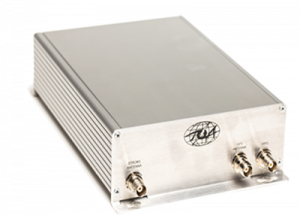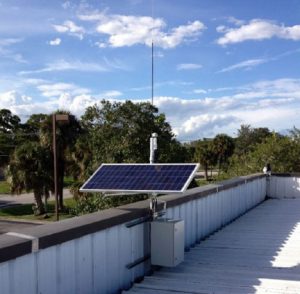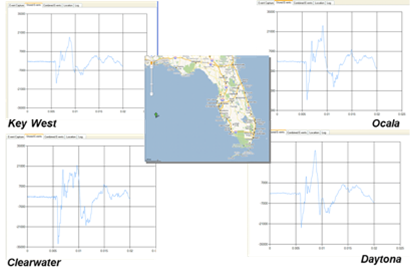Our sensors and patented methodology set us apart from others, tapping into the latest detection technologies deployed in a custom network to ensure accuracy at your areas of interest.
Partner with us to create a complete public or private lightning detection network that you can control. We provide you with the software and technology to process raw lightning data; we also maintain your network.
Sensors provide reliable lightning detection and discrimination
Our lightning sensors automatically detect and analyze the radio waves produced by each lightning strike. Know the precise time of detection, as well as rise time, fall time, amplitude, and a digitized output of the lightning waveform.
Lightning sensor management
Our exclusive sensor performance analysis tool allows authorized users to access and communicate directly with any of the active sensors. Remotely update software and firmware. Monitor oscillator frequency, power supply levels, temperature inside the sensor unit. Access a multitude of receiver parameters all through the tool.
Lightning analysis and location processing
Raw lightning data from sensors is relayed to the Central Analyzer Processor (CAP). The CAP is pre-programmed to contain information related to particular sensor sites in addition to mathematical and physical coefficients. With this information, the CAP computes a position for each lightning strike while effectively removing noise.
Lightning database functions
After the CAP calculates the strike location, it then transfers the data to an SQL cloud database-powered lightning archive.
Real-time display system
View real-time plots of cloud-to-ground and cloud-to-cloud lightning on a variety of map bases. Beyond graphical presentation, text-only messages are also available for output.
Performance monitoring and maintenance
Smart sensor tools collect, display, and store performance and status information for each network’s lightning detection instruments and processors. Information includes the number of times each sensor reports activity, the number of times the sensor takes part in a solution, and a broad range of other network performance data.
Sensor Technology
Lightning Sensor Technology


TOA’s LPS-200, with onboard digital signal processing, delivers the latest in precision sensor technology. Offering LF/VHF dual-band operation, the LPS-200 processes strikes from both cloud-to-ground and cloud-to-cloud lightning simultaneously.
Utilizing a high sensitivity, low noise wide-band receiver, state-of-the-art digital filters and equalizers, along with precision GPS time reference, the sensor is able to characterize and categorize each lightning stroke.
The LPS has enormous advantages over other lightning sensor designs, in particular those based on magnetic direction finding (MDF) which suffers from significant site introduced errors and consequent high siting costs. Precision lightning sensors used by TOA do not monitor magnetic field signals as do Direction Finding (MDF) based sensors, therefore sensors have liberal siting criteria.
Lightning Detector

The LPS can be installed on existing structures where access is available for both electric power and communications; remote site installation utilizing solar power is also available. The LPS is extremely adaptable in terms of communications — its design allows data transmission via phone, network, internet, or radio depending on situational requirements.
The detector part of the sensor is a broadband receiver. This picks up a substantial amount of the lightning energy that allows the system to distinguish between ground lightning and cloud lightning. With a broadband detector, the different characteristics of ground strokes and cloud strokes can be identified. This allows the classification of the detected strokes by the LPS sensors.
In a time-of-arrival based system, timing is an important part of the receiver. The LPS receiver uses commercial GPS timing as a reference. The sensor uses a high frequency timing source that makes the timing more stable, accurate, and increases the resolution. The timing is constantly monitored and corrected; this results in more accurate lightning locations.
An onboard processor handles communications, monitors the overall operation of the sensor, and keeps track of the timing system. The sensor is designed for remote configuration of the hardware. This is accomplished using Field Programmable Gate Array technology, allowing remote configuration of the hardware using bit patterns. Upgrades can be performed without visiting the site.
The sensor is also designed for remote configuration of the software. Software is downloadable over the communications link, and the programs are stored in non-volatile memory on the board. It is not affected by power glitches, losses, or outages.
Cloud Lightning Detection

Cloud lightning generates much higher short-term energy at higher frequencies than cloud-to-ground strokes, which the sensor identifies. The precise timing of a cloud pulse of a certain magnitude will allow the accurate location of that pulse using time-of-arrival mathematics.
Flexible communications
The LPS sensor supports various modern communications methods and is capable of operating through an on-board 10-Base-T network controller, as well as a standard serial communication circuit for modem or satellite communications.
Rugged and reliable antenna system
The LPS has two antennas; an active GPS antenna used for timing reference and a stroke detection antenna. Both antennas have a small footprint — and therefore low wind resistance — and are easily mounted on existing structures. They are designed for easy maintenance, and since there are no sensitive electronics mounted outdoors, site selection is simplified and reliability enhanced.
Comprehensive diagnostic capabilities
Built-in diagnostics monitor the system and allow remote access to sensitivity and other system settings.

